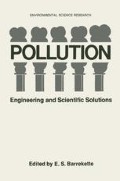Abstract
The application of Raman scattering to air pollution detection monitoring and measurement is considered. Some theoretical as well as practical aspects of the problem are discussed. Positive as well as negative features of the Raman scattering diagnostic techniques are pointed out. The problems associated with the utilization of lasers, the power requirements, frequency selection, pulse repitition rate and reliability are discussed. It is concluded that the diagnostic technique utilizing Raman scattering has sufficient outstanding features to make it particularly suitable for the task at hand.
Access this chapter
Tax calculation will be finalised at checkout
Purchases are for personal use only
Preview
Unable to display preview. Download preview PDF.
References
G. Herzberg, Infrared and Raman Spectra of Diatomic Molecules. D. Van Nostrand Co., Inc., New York (1945).
G. Herzberg, Infrared and Raman Spectra of Polyatomic Molecules. D. Van Nostrand.Co., Inc., New York (1945).
S-I Mizushima, Raman Effect. Handbuch der Physik, XXVI, Springer-Verlag (1958).
G.F. Widhopf and S. Lederman, AIAA Journal, 9, 309 (1971).
S. Lederman, Molecular Spectra and the Raman Effect. A Short Review. Polytechnic Institute of Brooklyn, PIBAL Rept. No. 71–15 (1971).
Cleaning Our Environment. A Report of the American Chemical Society, Washington, D.C. (1969).
Air Conservation Publication No. 80 of the American Association for the Advancement of Science, Washington, D.C. (1965).
L.R. Kohler, Ultraviolet Radiation. John Wiley and Sons, Inc., New York (1965).
E.J. Stansbury, M.F. Crawford, and H.L. Welsh, Canadian J. of Phys., 31 (1954).
H.W. Schrotter and H.J. Bernstein, J. Molecular Spectroscopy, 12, 1, (1964).
W.K. Pratt, Laser Communications Systems. John Wiley and Sons, Inc., New York, (1969).
S. Lederman, The Application of the Raman Effect to Remote Monitoring of Air Pollutants. Polytechnic Institute of Brooklyn, PIBAL Rept. No. 71–29 (1971).
Author information
Authors and Affiliations
Editor information
Editors and Affiliations
Rights and permissions
Copyright information
© 1973 Springer Science+Business Media New York
About this chapter
Cite this chapter
Lederman, S., Bloom, M.H. (1973). Remote Measurement of Air Pollutants Utilizing the Raman Effect. In: Barrekette, E.S. (eds) Pollution. Environmental Science Research, vol 2. Springer, Boston, MA. https://doi.org/10.1007/978-1-4899-0330-3_38
Download citation
DOI: https://doi.org/10.1007/978-1-4899-0330-3_38
Publisher Name: Springer, Boston, MA
Print ISBN: 978-1-4899-0332-7
Online ISBN: 978-1-4899-0330-3
eBook Packages: Springer Book Archive

